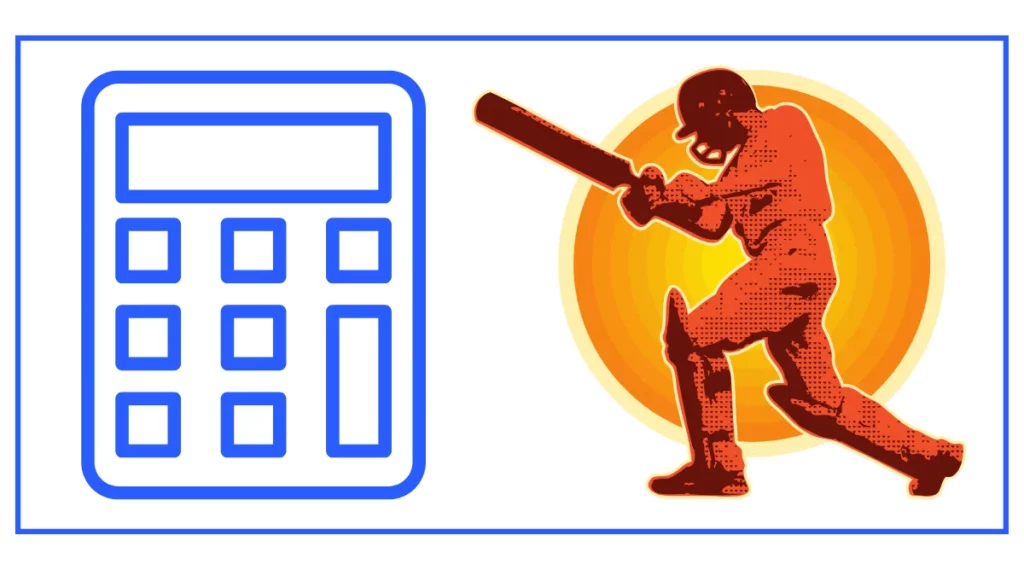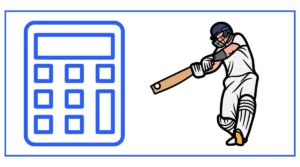Batting Strike Rate Calculator
Strike rate:
With the arrival of the T20 format, cricket has changed. Scoring 100 runs on 150 balls in an ODI match is no longer considered a great achievement. You need to score at least ball a run in order to cement your place in modern cricket.
The batting strike rate calculator allows you to calculate your batting strike rate by entering the number of runs scored and the number of balls faced.
You can easily find out your strike rate or the strike rate of your favorite player.
Can you, or your favorite place, beat them? Use the calculator to find out!

If you are a bowler, you are in the wrong place (joking). But I think you should be more interested in the bowling average.
What is a Batting Strike Rate?
The batting strike rate in cricket is a measure of how quickly a batsman scores runs. It’s calculated by dividing the number of runs scored by the number of balls faced, then multiplying by 100. This gives you the average number of runs scored per 100 balls faced.
How to Calculate Batting Strike Rate
To calculate a batting strike rate, follow these simple steps:
- Count the total number of runs scored by the batsman
- Count the total number of balls faced by the batsman
- Divide the runs scored by the balls faced
- Multiply the result by 100
The formula can be expressed as:
Batting Strike Rate = (Runs Scored / Balls Faced) × 100
Using the Batting Strike Rate Calculator
Our batting strike rate calculator simplifies this process. Here’s how to use it:
- Enter the total runs scored in the “Runs Scored” field
- Enter the number of balls faced in the “Balls Faced” field
- Click the “Calculate Strike Rate” button
- The calculator will display the strike rate to two decimal places
Why Batting Strike Rate Matters
The batting strike rate is a crucial metric in cricket, especially in limited-overs formats like T20 and One Day Internationals (ODIs). Here’s why it’s important:
- Measures scoring speed: It indicates how quickly a batter can score runs, which is vital in time-constrained formats.
- Strategy indicator: A high strike rate suggests an aggressive batting style, while a lower one might indicate a more defensive approach.
- Player comparison: It allows for easy comparison between batsmen, regardless of the number of balls they’ve faced.
- Match situation analysis: It helps in understanding if a player’s scoring rate matches the team’s needs in a particular game situation.
Interpreting Batting Strike Rates
While the interpretation of a “good” strike rate can vary depending on the format and situation, here are some general guidelines:
- In T20 cricket: A strike rate above 130–140 is considered good
- In ODIs: A strike rate above 80–90 is generally acceptable
- In Test cricket: Strike rates are less critical, but anything above 50 is usually positive
Remember, these are just guidelines. The “right” strike rate often depends on the match situation, team strategy, and the player’s role in the team.
Factors Affecting Batting Strike Rate
Several factors can influence a batsman’s strike rate, including:
- Batting position: Openers might have lower strike rates as they face new ball bowlers, while middle-order batsmen often have higher rates.
- Match format: T20 games typically see higher strike rates than Test matches.
- Pitch conditions: Difficult batting conditions can lead to lower strike rates.
- Bowling quality: Facing top-quality bowlers may result in lower strike rates.
- Match situation: The need for quick runs or to play defensively can affect strike rates.
Balancing Strike Rate and Batting Average
While the strike rate is important, it’s not the only metric to consider when evaluating a batsman’s performance. The batting average, which measures the average number of runs scored per dismissal, is equally crucial. A good batsman strikes a balance between these two metrics:
- Batting Average = Total Runs Scored / Number of Times Dismissed
- Strike Rate = (Runs Scored / Balls Faced) × 100
Ideally, a batsman aims for both a high average and a high strike rate. However, the emphasis on each can vary based on the player’s role and the game format.
Strike Rate in Different Cricket Formats
The importance and interpretation of strike rates vary across different cricket formats.
T20 Cricket
In T20, where each team has only 20 overs, strike rates are crucial. Batsmen aim for high strike rates, often above 130–140, to maximize run-scoring in the limited time available. Power hitting and aggressive batting are common features.
One Day Internationals (ODIs)
In ODIs with 50 overs per innings, strike rates are important but balanced with the need for building longer innings. A strike rate of 80-100 is often considered good, depending on the player’s role and match situation.
Test Cricket
In Test matches, which can last up to five days, strike rates are less critical. The focus is more on batting time and building large totals. However, a reasonable strike rate (above 50) is still beneficial, especially when trying to force a result.
Improving Your Batting Strike Rate
If you’re looking to improve your batting strike rate, consider these tips:
- Practice power hitting: Work on your ability to hit boundaries consistently.
- Improve shot selection: Learn to identify and capitalize on scoring opportunities.
- Develop a range of shots. A diverse shot repertoire allows you to score off more deliveries.
- Work on running between wickets: Quick singles and twos can boost your strike rate.
- Enhance fitness: Better fitness allows for more aggressive running and sustained power hitting.
Famous Cricketers Known for High Strike Rates
Several cricketers have made their mark with impressive strike rates.
- Andre Russell (T20I strike rate: 156.33)
- Glenn Maxwell (ODI strike rate: 125.22)
- Virender Sehwag (Test strike rate: 82.23)
These players are known for their explosive batting and ability to change the course of a game rapidly.
Limitations of the Strike Rate Metric
While the strike rate is a valuable metric, it has some limitations:
- It doesn’t account for the quality of bowling face.
- It doesn’t consider the match situation or pitch conditions.
- A high strike rate doesn’t always equate to effective batting, especially in longer formats.
Therefore, it’s important to consider the strike rate alongside other metrics and the broader context of the game.
FAQ
What is a good strike rate in cricket?
This depends on the format. In T20, above 130–140 is good. In ODIs, 80–100 is generally acceptable. In Tests, strike rates are less critical, but those above 50 is usually positive.
Can a batsman have a strike rate over 100?
Yes, a strike rate over 100 means the batsman is scoring more than one run per ball on average. This is common in T20 cricket and for aggressive batsmen in other formats.
How is the strike rate different from the run rate?
Strike rate is an individual metric for batsmen, measuring runs scored per 100 balls faced. Run rate is a team metric, measuring runs scored per over.
Does a high strike rate always mean a good performance?
Not necessarily. While a high strike rate indicates quick scoring, it needs to be balanced with the match situation, format, and the batsman’s role in the team.
Can strike rate be used to compare batsmen across different eras?
While it can be used, it’s important to consider the changes in playing conditions, rules, and overall scoring rates across different eras when making such comparisons.
Conclusion
The batting strike rate calculator is a simple yet powerful tool for cricket enthusiasts, players, and coaches. By understanding and using this metric effectively, you can gain valuable insights into batting performances and strategies.
Sources
- ESPNCRICINFO
- Cricket WEB
- How Stat





